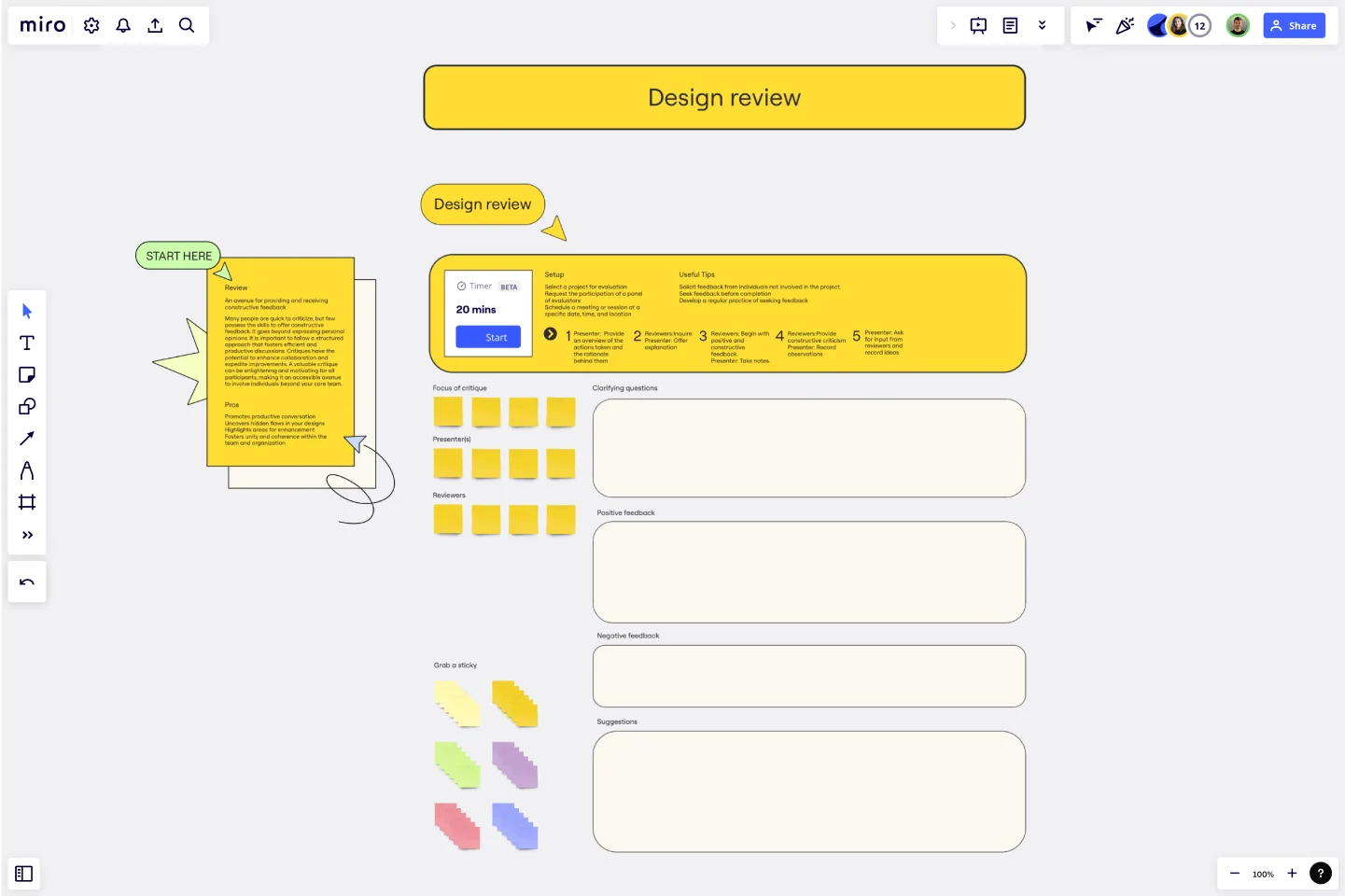Design Review Template
Provide and receive constructive feedback using this complete Design Review Template.
About the Design Review Template
Constructive feedback is a valuable skill that many people need to acquire. It is more than just sharing personal opinions. That's why the Design Review Template is so useful. It provides a structured approach that encourages effective and productive conversations.
Critiques are a powerful tool for promoting collaboration and driving improvement. A thoughtful critique can enlighten and inspire all participants, regardless of their position or role in a project. As a result, it is an accessible way to involve people beyond your core team.
Benefits of using the template
Promotes productive conversation.
Uncovers hidden flaws in your designs.
Highlights areas for enhancement.
Fosters unity and coherence within the team and organization.
How to use the template in Miro
Presenter: Provide an overview of the actions taken and the rationale behind them
Reviewers:InquirePresenter: Offer explanation
Reviewers: Begin with positive and constructive feedback. Presenter: Take notes.
Reviewers: Begin with positive and constructive feedback. Presenter: Take notes.
Presenter: Ask for input from reviewers and record ideas
Setup
Select a project for evaluation.
Request the participation of a panel of evaluators.
Schedule a meeting or session at a specific date, time, and location.
Useful tips
Solicit feedback from individuals not involved in the project.
Seek feedback before completion.
Develop a regular practice of seeking feedback.
Get started with this template right now.
Proto Persona Template
Works best for:
UX, UX Research, Product Design
The Proto Persona Template is tailored to capture the essence of hypothetical user segments. It encapsulates key attributes such as user needs, behaviors, and potential pain points. One of its standout benefits is its ability to foster empathy. By visualizing and understanding these preliminary user profiles, design and strategy teams can tap into a deeper connection with their target audience, ensuring that solutions resonate authentically and address genuine needs.
Design Sprint Kit Template
Works best for:
Agile Methodology, UX Design, Sprint Planning
With the right focused and strategic approach, five days is all it takes to address your biggest product challenges. That’s the thinking behind Design Sprint methodology. Created by Tanya Junell of Blue Label Labs, this Design Sprint Kit provides a set of lightweight templates that support the Design Sprint’s collaborative activities and voting—and maintains the energy, team spirit, and momentum that was sparked in the session. Virtual sprint supplies and prepared whiteboards make this kit especially useful for remote Design Sprint Facilitators.
Storyboard for Game Design Template
Works best for:
Storyboard
The Storyboard for Game Design template is a structured tool for visualizing your game’s development from concept to execution. It includes sections for roles, storyboarding, scripting, and asset management, ensuring clarity, consistency, and alignment across the team. Ideal for game designers, this template streamlines planning, helps manage resources, and promotes a cohesive and engaging gaming experience.
Proto Persona Template
Works best for:
Design
Business decisions frequently rely on the personal preferences and assumptions of internal employees. However, making decisions that prioritize the needs of the individuals being served is helpful. When personas are developed effectively, they provide guidance to you and your team, ensuring that the interests of these crucial stakeholders are considered when making significant decisions.
System Flowchart Template
The System Flowchart Template is a visual representation of the structure and organization of a concept, system, or solution. It helps teams understand how different components interact to form a functional system by focusing on the overall arrangement of elements rather than specific details. Symbolic drawings are used to illustrate the basic parts and their relationships in the diagram.
UXD Empathy Map Template
Works best for:
Research & Design, Market Research
UXD Empathy Map helps you gain a deep understanding of your users. By mapping their experiences, thoughts, and emotions, you can design products that truly resonate. This template is perfect for UX designers aiming to create user-centered designs.
